【商务谈判】04第四章国际商务谈判各阶段的策略
- 格式:ppt
- 大小:789.01 KB
- 文档页数:15
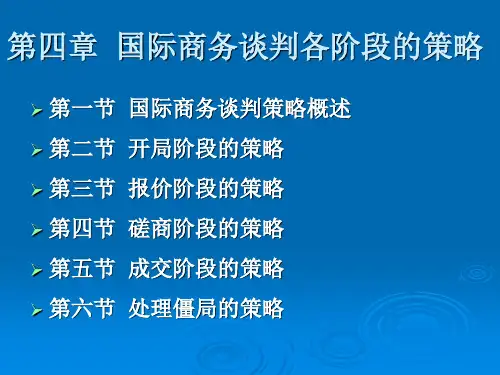
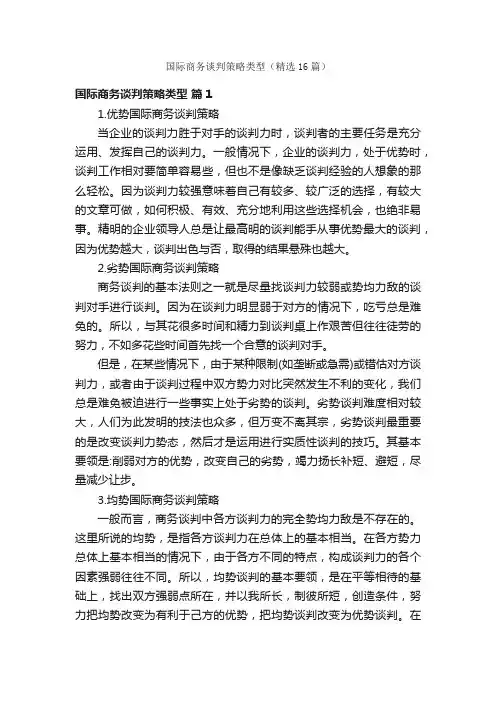
国际商务谈判策略类型(精选16篇)国际商务谈判策略类型篇11.优势国际商务谈判策略当企业的谈判力胜于对手的谈判力时,谈判者的主要任务是充分运用、发挥自己的谈判力。
一般情况下,企业的谈判力,处于优势时,谈判工作相对要简单容易些,但也不是像缺乏谈判经验的人想象的那么轻松。
因为谈判力较强意味着自己有较多、较广泛的选择,有较大的文章可做,如何积极、有效、充分地利用这些选择机会,也绝非易事。
精明的企业领导人总是让最高明的谈判能手从事优势最大的谈判,因为优势越大,谈判出色与否,取得的结果悬殊也越大。
2.劣势国际商务谈判策略商务谈判的基本法则之一就是尽量找谈判力较弱或势均力敌的谈判对手进行谈判。
因为在谈判力明显弱于对方的情况下,吃亏总是难免的。
所以,与其花很多时间和精力到谈判桌上作艰苦但往往徒劳的努力,不如多花些时间首先找一个合意的谈判对手。
但是,在某些情况下,由于某种限制(如垄断或急需)或错估对方谈判力,或者由于谈判过程中双方势力对比突然发生不利的变化,我们总是难免被迫进行一些事实上处于劣势的谈判。
劣势谈判难度相对较大,人们为此发明的技法也众多,但万变不离其宗,劣势谈判最重要的是改变谈判力势态,然后才是运用进行实质性谈判的技巧。
其基本要领是:削弱对方的优势,改变自己的劣势,竭力扬长补短、避短,尽量减少让步。
3.均势国际商务谈判策略一般而言,商务谈判中各方谈判力的完全势均力敌是不存在的。
这里所说的均势,是指各方谈判力在总体上的基本相当。
在各方势力总体上基本相当的情况下,由于各方不同的特点,构成谈判力的各个因素强弱往往不同。
所以,均势谈判的基本要领,是在平等相待的基础上,找出双方强弱点所在,并以我所长,制彼所短,创造条件,努力把均势改变为有利于己方的优势,把均势谈判改变为优势谈判。
在制定转化对策中,现代对策论将具有指导意义。
无论企业在谈判中处于优势、劣势或均势情形下,商务谈判的策略和技巧的运用都是非常重要的。
人们在实践中总结出了许多方法和技巧,掌握这些方法和技巧,对提高谈判力具有重要作用。
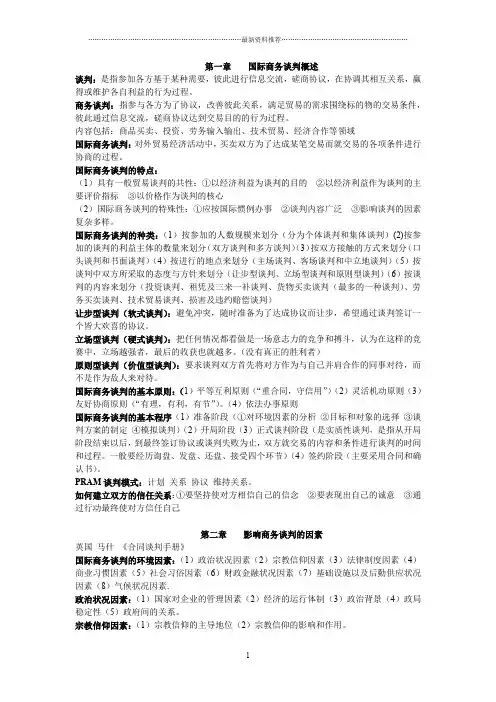
第一章国际商务谈判概述谈判:是指参加各方基于某种需要,彼此进行信息交流,磋商协议,在协调其相互关系,赢得或维护各自利益的行为过程。
商务谈判:指参与各方为了协议,改善彼此关系,满足贸易的需求围绕标的物的交易条件,彼此通过信息交流,磋商协议达到交易目的的行为过程。
内容包括:商品买卖、投资、劳务输入输出、技术贸易、经济合作等领域国际商务谈判:对外贸易经济活动中,买卖双方为了达成某笔交易而就交易的各项条件进行协商的过程。
国际商务谈判的特点:(1)具有一般贸易谈判的共性:①以经济利益为谈判的目的②以经济利益作为谈判的主要评价指标③以价格作为谈判的核心(2)国际商务谈判的特殊性:①应按国际惯例办事②谈判内容广泛③影响谈判的因素复杂多样。
国际商务谈判的种类:(1)按参加的人数规模来划分(分为个体谈判和集体谈判)(2)按参加的谈判的利益主体的数量来划分(双方谈判和多方谈判)(3)按双方接触的方式来划分(口头谈判和书面谈判)(4)按进行的地点来划分(主场谈判、客场谈判和中立地谈判)(5)按谈判中双方所采取的态度与方针来划分(让步型谈判、立场型谈判和原则型谈判)(6)按谈判的内容来划分(投资谈判、租凭及三来一补谈判、货物买卖谈判(最多的一种谈判)、劳务买卖谈判、技术贸易谈判、损害及违约赔偿谈判)让步型谈判(软式谈判):避免冲突,随时准备为了达成协议而让步,希望通过谈判签订一个皆大欢喜的协议。
立场型谈判(硬式谈判):把任何情况都看做是一场意志力的竞争和搏斗,认为在这样的竞赛中,立场越强者,最后的收获也就越多。
(没有真正的胜利者)原则型谈判(价值型谈判):要求谈判双方首先将对方作为与自己并肩合作的同事对待,而不是作为敌人来对待。
国际商务谈判的基本原则:(1)平等互利原则(“重合同,守信用”)(2)灵活机动原则(3)友好协商原则(“有理,有利,有节”)。
(4)依法办事原则国际商务谈判的基本程序(1)准备阶段(①对环境因素的分析②目标和对象的选择③谈判方案的制定④模拟谈判)(2)开局阶段(3)正式谈判阶段(是实质性谈判,是指从开局阶段结束以后,到最终签订协议或谈判失败为止,双方就交易的内容和条件进行谈判的时间和过程。
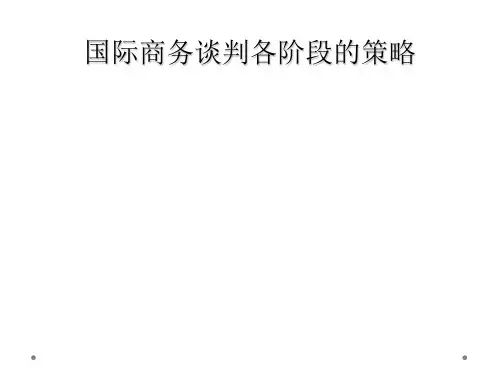

国际商务谈判的策略篇一:国际商务谈判策略一、国际商务谈判策略国际商务谈判的过程复杂多变,为了在复杂多变的谈判中取得满意的效果,得到实现利益目标的保证,必须在谈判中实施而灵活地实施有效的战略方案。
(一)策略的定义从企业经营的角度来说,国际商务谈判策略是为了实现企业的经营目标,在市场竞争的环境变化中求得生存和发展的一系列对策的总称;(二)制定国际商务谈判策略的步骤1、了解影响谈判的因素:(1)谈判人员要将主要问题、双方的态度、分歧、时间等因素组合分解成不同的部分,认真分析之后重新安排,以便组合出有利于自己的方式。
(2)谈判是一个动态的发展过程,要求谈判人员能够随时调整因素组合和谈判方案。
2、寻找关键问题:梳理分析双方主要分歧所在,要对关键问题作出明确的陈述与界定,理清问题的性质和该问题将对整个谈判的成功所起的作用等。
3、针对具体目标形成假设性方法(1)根据不同具体目标的不同特点,形成解决问题的途径和具体方法。
(2)对假设性方法进行深度分析,以是否“有效”即方法的针对性是否强和是否“可行”,即方法本身是否简便易行且在谈判对方的认可和接受范围之内。
4、形成具体谈判策略:(1)在进行深度分析的基础上,对拟定的谈判策略进行评价,得出最后结论,辨别上策、中策、下策。
(2)考虑在何时、以何种方式提出己方行动方案。
5、拟定行动计划方案:有了具体的谈判策略后,就要考虑谈判策略的实施。
要从一般到具体,提出每位谈判人员必须做到的事项,把它们在时间和空间上安排好,并进行反馈控制和追踪决策。
以上步骤只是制定谈判策略的一般规律,在具体实施过程中应灵活运用并随时根据需要进行调整。
二、开局阶段的策略开局阶段的重要性在实际谈判中,从谈判双方见面商议开始,到最后签约或成交为止,整个过程往往呈现出一定的阶段性,并且有很强的阶段性特点。
开局阶段主要是指谈判双方见面后,在讨论具体、实质性问题之前,相互介绍寒暄及就谈判内容以外的话题进行交谈的那段时间。
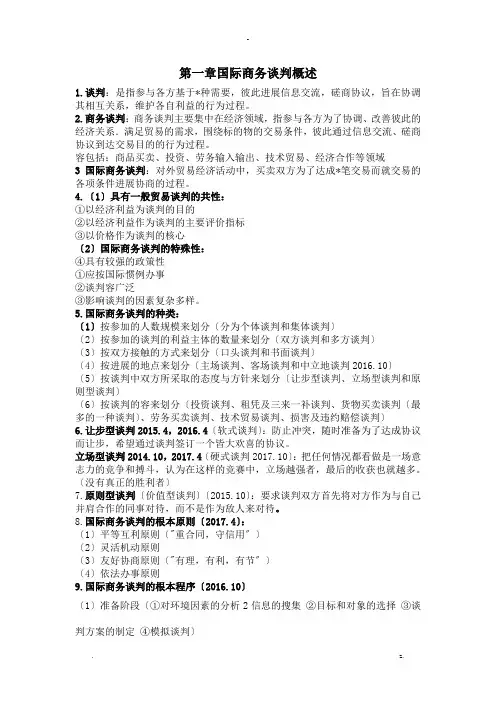
第一章国际商务谈判概述1.谈判:是指参与各方基于*种需要,彼此进展信息交流,磋商协议,旨在协调其相互关系,维护各自利益的行为过程。
2.商务谈判:商务谈判主要集中在经济领域,指参与各方为了协调、改善彼此的经济关系.满足贸易的需求,围绕标的物的交易条件,彼此通过信息交流、磋商协议到达交易目的的行为过程。
容包括:商品买卖、投资、劳务输入输出、技术贸易、经济合作等领域3国际商务谈判:对外贸易经济活动中,买卖双方为了达成*笔交易而就交易的各项条件进展协商的过程。
4.〔1〕具有一般贸易谈判的共性:①以经济利益为谈判的目的②以经济利益作为谈判的主要评价指标③以价格作为谈判的核心〔2〕国际商务谈判的特殊性:④具有较强的政策性①应按国际惯例办事②谈判容广泛③影响谈判的因素复杂多样。
5.国际商务谈判的种类:〔1〕按参加的人数规模来划分〔分为个体谈判和集体谈判〕〔2〕按参加的谈判的利益主体的数量来划分〔双方谈判和多方谈判〕〔3〕按双方接触的方式来划分〔口头谈判和书面谈判〕〔4〕按进展的地点来划分〔主场谈判、客场谈判和中立地谈判2016.10〕〔5〕按谈判中双方所采取的态度与方针来划分〔让步型谈判、立场型谈判和原则型谈判〕〔6〕按谈判的容来划分〔投资谈判、租凭及三来一补谈判、货物买卖谈判〔最多的一种谈判〕、劳务买卖谈判、技术贸易谈判、损害及违约赔偿谈判〕6.让步型谈判2015.4,2016.4〔软式谈判〕:防止冲突,随时准备为了达成协议而让步,希望通过谈判签订一个皆大欢喜的协议。
立场型谈判2014.10,2017.4〔硬式谈判2017.10〕:把任何情况都看做是一场意志力的竞争和搏斗,认为在这样的竞赛中,立场越强者,最后的收获也就越多。
〔没有真正的胜利者〕7.原则型谈判〔价值型谈判〕〔2015.10〕:要求谈判双方首先将对方作为与自己并肩合作的同事对待,而不是作为敌人来对待。
8.国际商务谈判的根本原则〔2017.4〕:〔1〕平等互利原则〔"重合同,守信用〞〕〔2〕灵活机动原则〔3〕友好协商原则〔"有理,有利,有节〞〕〔4〕依法办事原则9.国际商务谈判的根本程序〔2016.10〕〔1〕准备阶段〔①对环境因素的分析2信息的搜集②目标和对象的选择③谈判方案的制定④模拟谈判〕〔2〕开局阶段〔3〕正式谈判阶段〔是实质性谈判,是指从开局阶段完毕以后,到最终签订协议或谈判失败为止,双方就交易的容和条件进展谈判的时间和过程。


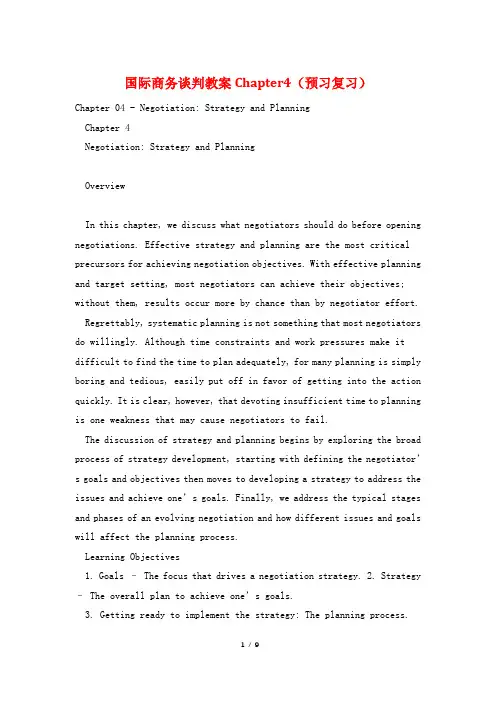
国际商务谈判教案Chapter4(预习复习)Chapter 04 - Negotiation: Strategy and PlanningChapter 4Negotiation: Strategy and PlanningOverviewIn this chapter, we discuss what negotiators should do before opening negotiations. Effective strategy and planning are the most critical precursors for achieving negotiation objectives. With effective planning and target setting, most negotiators can achieve their objectives; without them, results occur more by chance than by negotiator effort. Regrettably, systematic planning is not something that most negotiatorsdo willingly. Although time constraints and work pressures make it difficult to find the time to plan adequately, for many planning is simply boring and tedious, easily put off in favor of getting into the action quickly. It is clear, however, that devoting insufficient time to planningis one weakness that may cause negotiators to fail.The discussion of strategy and planning begins by exploring the broad process of strategy development, starting with defining the negotiator’s goals and objectives then moves to developing a strategy to address the issues and achieve one’s goals. Finally, we address the typical stages and phases of an evolving negotiation and how different issues and goals will affect the planning process.Learning Objectives1. Goals – The focus that drives a negotiation strategy.2. Strategy– The overall plan to achieve one’s goals.3. Getting ready to implement the strategy: The planning process.I. Goals – The Focus That Drives a Negotiation StrategyA. Direct effects of goals on choice of strategy1. There are four important aspects to understand about how goals affect negotiations: a. Wishes are not goals, especially in negotiation. b. Goals are often linked to the other party’s goals. c. There are boundaries or limits to what goals can be.d. Effective goals must be concrete, specific and measurable. If they are not, then itwill be hard to:(1) Communicate to the other party what we want (2) Understand what the other party wants(3) Determine whether an offer on the table satisfies our goals.2. Goals can be tangible or procedural.4-1Chapter 04 - Negotiation: Strategy and Planning3. The criteria used to determine goals depend on your specific objectives and your priorities among multiple objectives.B. Indirect effects of goals on choice of strategy1. Short-term thinking affects our choice of strategy; in developing and framing our goals, we may ignore the present or future relationship with the other party in a concern for achieving a substantive outcome only.2. Negotiation goals that are complex or difficult to define may requirea substantial change in the other party’s attitude. In most cases, progress will be madeincrementally, and may depend on establishing a relationship with the other party.II. Strategy – The Overall Plan to Achieve One’s GoalsA. Strategy versus Tactics1. A major difference between strategy and tactics is that of scale, perspective or immediacy.2. Tactics are short-term, adaptive moves designed to enact or pursue broad strategies, which in turn provide stability, continuity, and direction for tactical behaviors.3. Tactics are subordinate to strategy: they are structured, directed, and driven by strategic considerations.B. Unilateral versus bilateral approaches to strategy1. A unilateral choice is made without the active involvement of the other party.2. Unilaterally pursued strategies can be wholly one-sided and intentionally ignorant of any information about the other negotiator.3. Unilateral strategies should evolve into ones that fully consider the impact of the other’s strategy on one’s own.C. The dual concerns model as a vehicle for describing negotiation strategies. This model proposes that individuals have two levels of related concerns: a concern for their own outcomes, and a level of concern for the other’s outcomes.1. Alternative situational strategiesa. There are at least four different types of strategies when assessing the relativeimportance and priority of the negotiator’s substantive outcome versus the relational outcome: competitive, collaboration, accommodation, and avoidance2. The nonengagement strategy: Avoidancea. There are many reasons why negotiators may choose not to negotiate:(1) If one is able to meet one’s needs without negotiating at all, it may make sense to use an avoidance strategy(2) It simply may not be worth the time and effort to negotiate (although there are sometimes reasons to negotiate in such situations4-2Chapter 04 - Negotiation: Strategy and Planning(3) The decision to negotiate is closely related to the desirability of availablealternatives – the outcomes that can be achieved if negotiations don’t work out3. Active-engagement strategies: Competition, collaboration, and accommodation a. Competition is distributive win-lose bargaining. b. Collaboration is integrative or win-win negotiation.c. Accommodation is as much a win-lose strategy as competition, although it has adecidedly different image it involves an imbalance of outcomes, but in the opposite direction. (“I lose, you win” as opposed to “I win, you lose.”) d. There are drawbacks to these strategies if applied blindly, thoughtlessly orinflexibly:(1) Distributive strategies tend to create “we-they” or “superiority-inferiority” patterns, which may result in a distortion of the other side’s contributions, as well as their values, needs and positions.(2) If a negotiator pursues an integrative strategy without regard to the other’s strategy, then the other may manipulate and exploit the collaborator and take advantage of the good faith and goodwill being demonstrated.(3) Accommodative strategies may generate a pattern of constantly giving in to keep the other happy or to avoid a fight.III. Understanding the Flow of Negotiations: Stages and PhasesA. Phase models of negotiation:1. Initiation2. Problem solving3. ResolutionB. Greenhalgh (2001) suggests that there are seven key steps to an ideal negotiation process:1. Preparation: deciding what is important, defining goals, thinking ahead how to work together with the other party.2. Relationship building: getting to know the other party, understanding how you and the other are similar and different, and building commitment toward achieving a mutually beneficial set of outcomes.3. Information gathering: learning what you need to know about the issues, about the other party and their needs, about the feasibility of possible settlements, and about what might happen if you fail to reach agreement with the other side.4. Information using: at this stage, negotiators assemble the case they want to make for their preferred outcomes and settlement, one that will maximize the negotiator’s own needs.5. Bidding: the process of making moves from one’s initial, ideal position to the actual outcome.6. Closing the deal: the objective here is to build commitment to the agreement achieved in the previous phase.7. Implementing the agreement: determining who needs to do what once hands are shaken and the documents signed.4-3Chapter 04 - Negotiation: Strategy and PlanningIV. Getting Ready to Implement the Strategy: The Planning Process A. Defining the issues1. Usually begins with an analysis of what is to be discussed in the negotiation.2. The number of issues in a negotiation, along with the relationship between thenegotiator and the other party, are often the primary determinant of whether one uses a distributive or integrative strategy.3. In any negotiation, a complete list of the issues at stake is best derived from the following sources:a. An analysis of all the possible issues that need to be decided.b. Previous experience in similar negotiations.c. Research conducted to gather information.d. Consultation with experts in that industry.B. Assembling the issues and defining the bargaining mix1. The combination of lists from each side in a negotiation determines the bargaining mix.2. There are two steps a negotiator can use to prioritize the issues on an agenda: a. Determine which issues are most important and which are less important. b. Determine whether the issues are linked together or are separate.C. Defining Interests1. Interests may be:a. Substantive, that is, directly related to the focal issues under negotiation.b. Process-based, that is, related to how the negotiators behave as they negotiate.c. Relationship-based, that is, tied to the current or desired future relationshipbetween the parties.2. Interests may also be based on intangibles of negotiation.D. Knowing limits and alternatives1. Good preparation requires that you establish two clear points:a. Resistance point – the place where you decide that you should absolutely stop thenegotiation rather than continue.b. Alternatives – other agreements negotiators could achieve and still meet theirneeds. Alternatives define whether the current outcome is better than another possibility.E. Setting targets and openings1. Two key points should be defined in this step:a. The specific target point where one realistically expects to achieve a settlement4-4Chapter 04 - Negotiation: Strategy and Planningb. The asking price, representing the best deal one can hope to achieve.2. Target setting requires positive thinking about one’s own objectives.3. Target setting often requires considering how to package several issues and objectives.4. Target setting requires an understanding of trade-offs and throwaways.F. Assessing constituents and the social context of a negotiation1. When people negotiate in a professional context, there may be more than two parties. a. There may be more than two negotiators at the table. Multiple parties often leadto the formation of coalitions.b. Negotiators also have constituents who will evaluate and critique them.c. Negotiation occurs in a context of rules – a social system of laws, customs,common business practices, cultural norms, and politicalcross-pressures.2. “Field analysis” can be used to assess all the key parties in a negotiation. a. Who is, or should be, on the team on my side of the field?b. Who is on the other side of the field?c. Who is on the sidelines and can affect the play of the game? Who are thenegotiation equivalents of owners, managers and strategists?d. Who is in the stands? Who is watching the game, is interested in it, but can onlyindirectly affect what happens?e. What is going on in the broader environment in which the negotiation takesplace?f. What is common and acceptable practice in the ethical system in which the deal isbeing done?g. What is common and acceptable practice given the culture in which thenegotiation is conducted?G. Analyzing the other party1. Learning the other’s issues, preferences, priorities, interests, alternatives and constraints is almost as important as determining one’s own.2. Several key pieces of background information will be of great importance, including: a. The other party’s resources, issues, and bargaining mix – investigate:(1) Other party’s business history or previous negotiations. (2) Financial data. (3) Inventories.(4) Visit or speak with the other party’s friends and peers. (5) Question past business partners. b. The other party’s interests and needs.(1) Conduct a preliminary interview including a broad discussion of what the other party would like to achieve in the upcoming negotiations. (2) Anticipating the other party’s interests.(3) Asking others who know or have negotiated with the other party. (4) Reading how the other party portrays him/herself in the media.4-5。
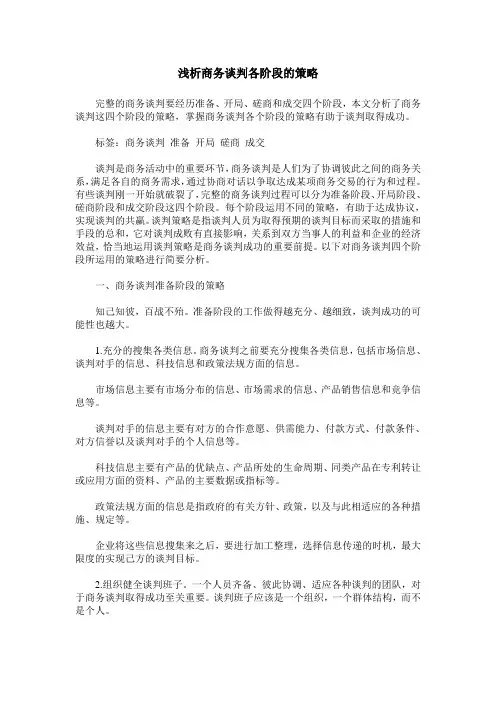
浅析商务谈判各阶段的策略完整的商务谈判要经历准备、开局、磋商和成交四个阶段,本文分析了商务谈判这四个阶段的策略,掌握商务谈判各个阶段的策略有助于谈判取得成功。
标签:商务谈判准备开局磋商成交谈判是商务活动中的重要环节,商务谈判是人们为了协调彼此之间的商务关系,满足各自的商务需求,通过协商对话以争取达成某项商务交易的行为和过程。
有些谈判刚一开始就破裂了,完整的商务谈判过程可以分为准备阶段、开局阶段、磋商阶段和成交阶段这四个阶段。
每个阶段运用不同的策略,有助于达成协议,实现谈判的共赢。
谈判策略是指谈判人员为取得预期的谈判目标而采取的措施和手段的总和,它对谈判成败有直接影响,关系到双方当事人的利益和企业的经济效益,恰当地运用谈判策略是商务谈判成功的重要前提。
以下对商务谈判四个阶段所运用的策略进行简要分析。
一、商务谈判准备阶段的策略知己知彼,百战不殆。
准备阶段的工作做得越充分、越细致,谈判成功的可能性也越大。
1.充分的搜集各类信息。
商务谈判之前要充分搜集各类信息,包括市场信息、谈判对手的信息、科技信息和政策法规方面的信息。
市场信息主要有市场分布的信息、市场需求的信息、产品销售信息和竞争信息等。
谈判对手的信息主要有对方的合作意愿、供需能力、付款方式、付款条件、对方信誉以及谈判对手的个人信息等。
科技信息主要有产品的优缺点、产品所处的生命周期、同类产品在专利转让或应用方面的资料、产品的主要数据或指标等。
政策法规方面的信息是指政府的有关方针、政策,以及与此相适应的各种措施、规定等。
企业将这些信息搜集来之后,要进行加工整理,选择信息传递的时机,最大限度的实现己方的谈判目标。
2.组织健全谈判班子。
一个人员齐备、彼此协调、适应各种谈判的团队,对于商务谈判取得成功至关重要。
谈判班子应该是一个组织,一个群体结构,而不是个人。
商务谈判班子中要有谈判小组的领导人、懂行的专家或专业人员以及必须的工作人员。
谈判人员要遵守“礼、诚、信”的谈判职业准则,要有求胜的决心、毅力和耐力,要最大限度的维护和争取己方的利益;谈判人员的专业知识要精,知识面要广;要有较强的交际能力、表达能力和判断能力。

第一章国际商务谈判概述、特点、种类、基本原则、基本程序。
1.2001年12月11日中国成为世界贸易组织正式成员。
2.谈判的目的:协调利益冲突,实现共同利益。
3.商务谈判是市场经济条件下流通领域最普遍的活动之一。
4.国际商务谈判:在国际商务活动中,处于不同国家或不同地区的商务活动当事人为了达成某笔交易,彼此通过信息交流,就交易的各项要件进行协商的行为过程。
5.国际商务谈判的特点:1、国际商务谈判具有一般贸易谈判的共性(1以经济利益为谈判的目的,2以经济利益作为谈判的主要评价指标,3以价格作为谈判的核心)2、国际商务谈判的特殊性.具有较强的政策性(1国际商务谈判既是一笔交易的商洽,也是一项涉外活动,具有较强的政策性 2应按国际惯例办事 3国际商务谈判内容广泛 4影响谈判的因素复杂多样。
)6.国际商务谈判按参加谈判的人数规模来分:个体谈判,集体谈判。
按参加谈判的利益来分:双方谈判,多方谈判。
双方接触的方式来分:口头谈判,书面谈判,按谈判进行的地点:主场谈判、客场谈判、中立地谈判。
7.按谈判中双方所采取的态度与方针划分:让不型谈判法、立场型谈判发、原则型谈判法。
8.影响和制约以上三种谈判方法运用的因素有:1今后与对方继续保业务关系的可能性2对方的谈判实力与己方的谈判实力的对比3该笔交易的重要性4谈判在人力、物力、财力和时间方面的限制。
9.按谈判内容来划分:投资谈判、租凭及“三来一补”谈判、货物买卖谈判、劳务买卖谈判、技术贸易谈判、损害及违约赔偿谈判。
10.投资谈判:把一定的资本投入和与运用于某一项以营利为目的的事业。
11.租凭谈判是指我国企业从国外租用机器和设备而进行的谈判,“三来一补”从国外来料加工,来样加工,来件装配业务,一补指补偿贸易。
12.我国国际商务谈判的基本原则:平等互利原则、灵活机动原则、友好协商原则、依法办事原则。
13.平等互利原则:在商务活动中,双方的实力不分强弱,在相互关系中应处于平等地位;在商品交换中,自愿让渡商品,等价交换;谈判双方应根据需要与可能,有来有往,互通有无,做到双方互利。
商务谈判磋商阶段的策略1.估价要略高价格谈判中估价是出价的依据,估价或出价之所以要略高,一是人们普遍有“一分钱一分货”的心理倾向;二是商业惯例;三是谈判本身要求留有回旋余地;四是有助于削弱对方的信心,摸清对方的承受力,提高对方的价格接受水平。
一般情况下,卖方的开盘价必须是最高的,相应地对买方来讲,开盘价必须是最低的,这是报价的首要原则。
2.出价要坚定在出价前要准备掌握好估价的充分资料,出价时一定要严肃、认真、坚定、自信、准确。
出价以后,言谈和行动中都必须体现出以出价为势在必得,对出价表现出充分的自信,对报价不必作解释或说明。
3.杀价要狠、让步要慢在杀价和让步过程中,还应该尽量制造竞争,制造竞争可以使自己至少在表面上处于有利地位。
1.先报价与后报价摸底的目的就是为提出本方的交易条件及报价做准备。
经过摸底之后,双方即开始报价。
先报价还是后报价,根据利弊关系来确定。
先报价的优点在于:一方面,先报价对谈判的影响较大,它实际上等于为谈判划定了一个框架,最终协议将在这个范围内达成。
比如,卖方报价某种数控机床每台600万元,那么经过双方协商之后,最终成交价格一定不会超过600万元这个界限的。
另一方面,先报价如果出乎双方的预料和设想,往往会打乱对方原有的部署,甚至动摇对方原来的期望值,使其失去信心。
比如,卖方首先报价某种数控机床每台800万元,而买方心理却只能承受500万元,这与卖方报价相差太远,即使经过进一步磋商也很难达成协议。
因此,只好改变原来部署,要么提价,要么告吹。
总之,先报价在整个谈判过程中都会持续地起作用,因此,先报价比后报价的影响要大得多。
当然先报价也存在一定的缺点:一方面,对方听了另一方的报价之后,可以对他们自己原有的想法进行最后的调整。
由于卖方先报价,买方对卖方的交易条件起点有所了解,他们就可以修改原先准备的报价,获得本来得不到的好处。
例如卖方报价每台数控机床600万元,而买方原来准备的报价可能为700万元一台。
国际商务谈判策划书国际商务谈判策划书范文时光在流逝,从不来停歇,一段时间的工作已经告一段落,我们又有了新的工作内容和新的工作目标何不赶紧趁现在写写策划书。
那么我们该怎么去写策划书呢?下面是小编为大家整理的国际商务谈判策划书范文,欢迎阅读与收藏。
国际商务谈判策划书范文1(一)前言为了成功举地举办此次体育竞赛,我校(甲方)一直在寻求企业赞助合作。
经过初步的接触,目前已经有两家比较合适的公司(乙方:广州怡宝有限公司、广州中顺洁柔纸业有限公司、广州华强制衣实业有限公司)有合作意向。
甲方(我方)在和乙方的初次接触中介绍了关于竞赛的策划及组织情况,乙方表示希望双方能进一步深谈并要求我方在正式会晤前,至少提前三天提交给乙方一份赞助合作提案(包括赞助具体形式赞助回报等相关内容,可以参考相关资料。
)双方预定在三天后晚上7:30分进行谈判,地点乙方会议室。
(二)谈判标题1、主题:关于2014年广州地区中职学校学生田径运动会赞助谈判2、谈判项目:2014年广州地区中职学校学生田径运动会赞助。
3、谈判主体:甲方:广东省林业职业技术学校乙方:广东华强制衣实业有限公司4、双方主要简介:我方:广东省林业职业技术学校,本届田径运动会承办方,重点中职学校。
对方:广东华强制衣实业有限公司独立拥有一座新落成的现代花园式标准的工业园,是“ISO9001:2000国际质量标准体系认证企业。
”获得“中国质量信用企业AAA级,”“中国品牌建设十大杰出企业”“中国服装行业十大影响品牌”光荣称号。
5、双方主要优势:我方:环境优美,交通方便,建校历史悠久,设备齐全,国家重点中职学校。
对方:“华强”是“ISO9001:2000国际质量标准体系认证企业。
”获得“中国质量信用企业AAA级,”“中国品牌建设十大杰出企业”“中国服装行业十大影响品牌”光荣称号。
(三)双方背景分析甲方(我方):广东省林业职业技术学校创办于1953年,占地780亩,先后被授予文明校园、广州市花园式单位、广东省文明单位等荣誉,是广东省林业中等职业技术学校,林业类、园林类专业是我校与省教育厅共建的重点示范专业。